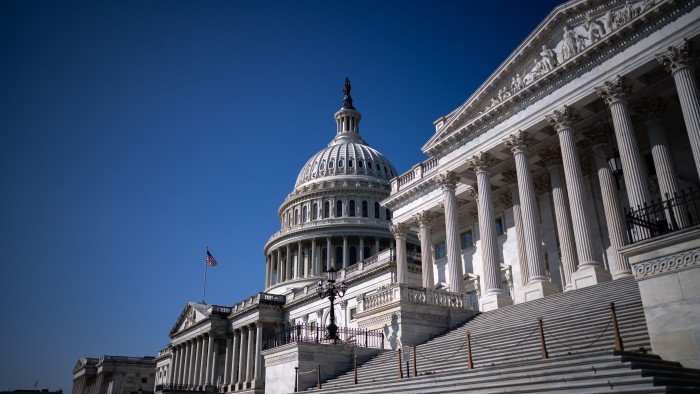Unlock the White House Watch newsletter for free
Your guide to what Trump’s second term means for Washington, business and the world
Donald Trump’s tariff drive will cut US deficits by $4tn over the coming decade, according to Congress’s fiscal watchdog, helping to offset concerns that the president’s tax bill will worsen the country’s public finances.
The Congressional Budget Office said on Friday that tariffs announced so far this year would reduce primary deficits by $3.3tn over the period to 2035, while interest payments would fall by an additional $700bn.
“As a result, the changes in tariffs will reduce total deficits by $4tn altogether,” said Phillip Swagel, director of the CBO, a non-partisan agency that sits within the legislative branch of government.
The overall effect of the levies on debt levels over the period is about a third higher than the $3tn estimated by the CBO based on measures announced between January and mid-May.
The latest estimates suggest that the impact of tariff revenue will dull the fiscal hit from Trump’s landmark spending legislation, the One Big Beautiful Bill Act, which is projected to increase debt levels by $4.1tn over the period.
The president seized on the report on Friday, saying it showed “that Trump was right” and that the tariff revenues “are going to reduce the deficit by numbers far greater than they ever expected — unheard of”.
The US’s public finances have been a central theme for investors in recent months, with some money managers cautioning that the country’s debt-to-GDP ratio of about 100 per cent has dented the allure of Treasuries.
The CBO analysis does not account for the impact of the tariffs on the size of the economy. Economists expect the levies to be a drag on growth.
Swagel also cautioned that the estimates were “subject to significant uncertainty”, citing “questions about timing, possible exceptions, and a lack of precedents”.
The report is nonetheless a boost to Trump and members of his administration, who have long argued that the levies would swell government coffers enough to offset the effects of additional spending.
Treasury secretary Scott Bessent said on Tuesday that he expected tariff revenue this year to rise “substantially” from his previous assumptions.
“We’re going to bring down the deficit to GDP. We’ll start paying down the debt, and then at that point that can be used as an offset to the American people,” he told CNBC.
This year alone, current tariffs were expected to bring in about $200bn in revenues, according to the CBO, up from about $80bn annually over the past five years.
Credit rating agency S&P Global this week pointed to the influx of tariff revenues in its decision to hold its rating on US government debt steady, despite the impact of the spending bill.
Lisa Schineller, director of sovereign ratings at S&P, said that while there were still significant unknowns about how the levies play out, “you’re going to have what we think is some pretty important tariff revenue”.
“We think . . . that the tariff revenue could potentially offset some of what we see as the fiscal deterioration or weakness that would come from that bill,” said Schineller.
Fitch, another rating agency, also cited the effect of a “surge in tariff revenues” on government coffers in its decision on Friday to hold its rating on US debt steady. But it cautioned that “large fiscal deficits” would “persist”, with the general government deficit rising again in 2026 and 2027 after a drop this year.
Some analysts cautioned that the impact of tariffs risked being overstated in the long run, however, with their positive effect on US public finances likely to fade over time.
Recommended
“It’s a temporary fillip, but not something that’s really going to change the overall story,” said Thomas Torgerson, managing director at Morningstar. “There’s not a lot of clarity on how much of that revenue will actually be durable and be received year after year after year.”
Once tariff rates settle, he said, there was a risk of “trade diversion” where exporters shift their focus away from the US and towards countries with lower levies. “So what you ultimately have is weaker revenue flow over the medium term.”
Additional reporting by Stephanie Stacey in Washington



